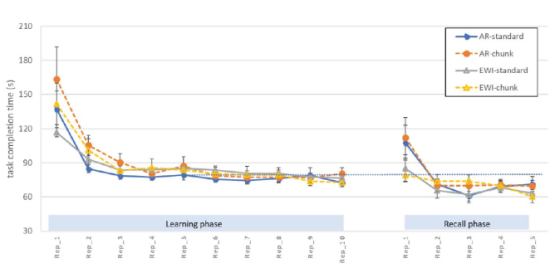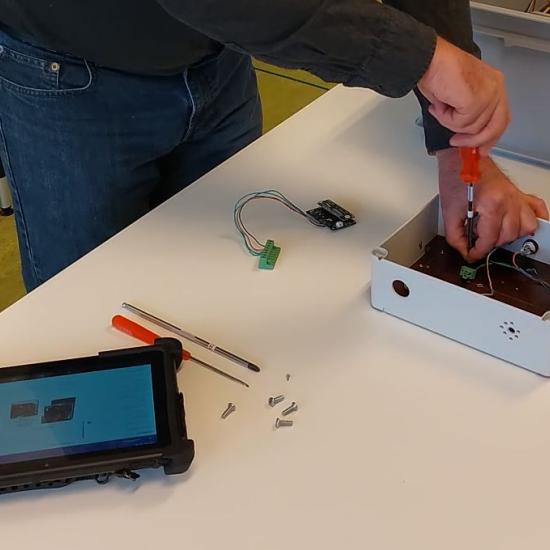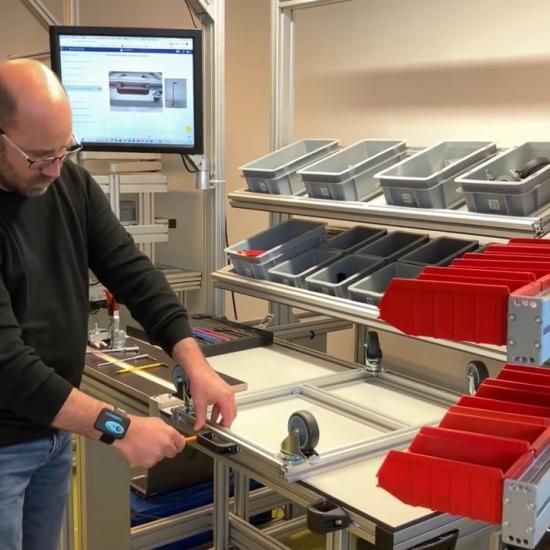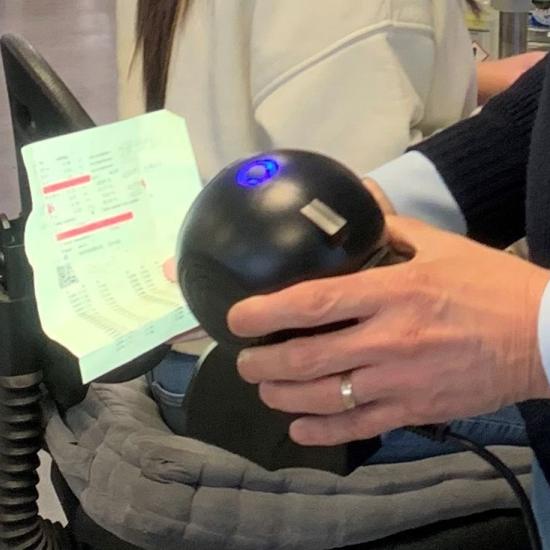In recent years, many studies have been published on the effectiveness of digital work instructions. This has yielded many valuable lessons for manufacturing companies, which we summarise for you in this article.
We may not always realise it, but our lives depend on the existence of good work instructions. For example, it has long been the experience of the nuclear and aviation sectors that trusting to memory and habit is dangerous. More recently, a surgical checklist for operating theatres was launched by the World Health Organisation. This checklist has halved the number of complications and deaths on the operating table. The use of paper-based instructions has long been the norm in industry. However, digital work instruction systems have been on the rise for several years now. This raises the question of what companies can actually expect from such systems. In this article, we use recent studies to highlight the benefits of digital instruction systems when compared to paper instructions.
Some studies highlighted
A study by RWTH Aachen University compared the use of paper instructions, digital instructions and a combination of paper and digital instructions. During the study, 66 participants had to assemble four metal pencil boxes. The digital instructions allowed users to interact with a 3D model and navigate through the various steps.
Figure 1 shows how the different instruction methods affect the installation time and the number of quality problems. The curves show a clear learning effect. The fourth pencil box was assembled twice as quickly as the first with only half as many errors.
The assembly time for the four products was on average 12 percent shorter with digital work instructions than with paper instructions. This advantage falls off as the operator assembles more products. With the fourth product, the time gain was only 4 percent. It is also striking that digital instruction systems reduce the number of quality problems by half compared to paper work instructions. Combining digital work instructions system with paper instructions does not offer any additional advantage.
Figure 1: Impact of digital work instruction systems: left, effect on error load; right effect on assembly time
(Source: Letmathe et al 2021)
A TNO study investigated the difference between electronic work instructions (EWI) via a tablet and an augmented reality projection system (AR). In the study, 24 participants had to perform an assembly task. After a digitally assisted learning phase in which the subjects made 10 products, the system was turned off. Figure 2 shows the results of the study. A strong learning effect is again evident. During the assembly of the first four products, the assembly time decreased sharply and then stabilised. The study found no significant differences between the instructional systems in terms of quality and productivity. It is interesting to note what happened when the instruction system was shut down. The installation time initially increased in what is called the 'recall' phase, after which this time decreased. The assembly time without an instruction system was ultimately 5 percent shorter than with an instruction system. Switching off the system did not affect the quality. The difference in assembly time is explained by the fact that the interaction with the instruction system itself also takes some time.
Figure 2: Effect of digital work instruction systems during and after the learning phase
(Source: Wilschut et al, 2019)
In another TNO study, however, the researchers noticed a major effect when using a projection system. In this study, subjects had to pick parts from 16 possible bins and put them in a specific place. The use of a projection system, in which both the bin and the place on the board were illuminated, accelerated the pick-and-place time by 70 percent relative to instruction via a tablet. The quality also improved significantly. The placement errors fell by 100 percent and the orientation errors of the parts fell by 50 percent.
Several studies also compared the use of digital work instructions displayed on a screen with instructions delivered through a Microsoft Hololens headset. These studies gave mixed results. The effect of a HoloLens seems to depend greatly on the circumstances. A Swiss study on the conversion of an ultrasonic welding machine found a 35 percent reduction in the conversion time when using a HoloLens compared to both paper instructions and PDF instructions on a tablet. However, this considerable difference in speed was attributed to the way the structure of the instructions differed rather than to the HoloLens itself. In the test with the HoloLens, the instructions were provided step-by-step. As a result, the participants skipped fewer steps and were less likely to lose their way in the instructions. The instructions with the HoloLens were, incidentally, executed more slowly, but the conversion was still successfully completed earlier thanks to the lower burden of error.
A study by Flanders Make also concluded that instructions on a tablet are executed significantly faster than with a HoloLens. The participants in this study also preferred to use a tablet for ergonomic reasons. An American study, on the other hand, concluded that a HoloLens reduced the assembly time of a wing by 16 percent.
However, not all experimental comparisons between digital and paper instructions gave positive results. In a German study, paper instructions actually outperformed instructions given via smart glasses (Google Glass). The subjects in this study reported problems with their vision and suffered from headaches.
Conclusions
It is hard to unambiguously quantify the effect of digital instruction systems because many factors are involved, including the nature and complexity of the task, the application in question (during training or production) and the choice of the system (tablet, projection system or headset). Nevertheless, it is possible to set out a number of clear conclusions.
- Simply putting a digital copy of traditional paper instructions on a screen - in PDF format for example - is not a good solution. Digitisation only gains its full effect when you make digital instructions better than paper ones. Digital instruction systems outperform paper instructions to the extent that they provide the following functionalities:
-
- Clear visualisation of the active step: employees can get lost in instructions and skip steps. Showing only the current step or highlighting the current step makes it easier to follow the instructions consistently.
- Simplifying the procedural logic: instructions with conditional steps ”IF X, THEN…” and instructions with logical operators (“AND” and “OR”) are difficult to follow. Digital instructions with guided questions can simplify this by removing the need for operator reasoning. The system then simply asks “Do you see situation X or situation Y?” Depending on the choice, only the relevant instruction is shown.
- Verification of components: digital systems can ask for the code of a component to be scanned first. If the wrong component is offered, the instruction stops and the employee then has to look for the right one.
- Computational help: measured values often have to be compared with prescribed values or simple calculations have to be made. This is error-prone work that computers can easily take over. It is then sufficient to enter the measured value, after which the instruction system itself performs a check.
- Linkage to other systems: By linking digital work instruction systems to, for example, an ERP system, the correct instruction can be automatically retrieved, and the employee does not have to look up the instruction. Linkage also makes it possible to easily retrieve data, such as drawings, from other systems.
- Ensuring effective use: in the past, we saw processes where paper measurement sheets had already been filled in before production had taken place. The effective use of digital tools can be easily checked with digital timestamps.
- Enriching the instructions with photos, animations and videos: adding images - especially animations and video - helps operators understand the instructions faster and better.
- Interactivity: digital instruction allows better interaction with the instructions by allowing, for example, zooming-in and rotating 3D models.
- Digital instruction systems affect quality and production time. The effect on quality is stronger than the effect on production time. In some augmented reality applications, the quality problems can even disappear completely.
- Digital instruction systems accelerate the learning process during the training phase. For simple tasks, the continuous use of digital instructions during actual production is of limited benefit. In some cases, the unnecessary interaction with the instruction system can even lengthen production time slightly. As the tasks become more complex or error-prone, the benefit during production increases.
- The choice of the right type of digital instruction system (tablet, projection, headset) largely determines the effect of the system. This choice strongly depends on the application in question. The comfort requirements of the users must also be taken into account.
- Digital instruction systems not only improve the work of the operators, they also simplify the creation and management of the instructions by employees.
In short, digital instruction systems have a clear advantage in many cases over paper instructions. The most commonly-used digital instruction systems are also quite affordable, which means that every manufacturing company should consider a pilot project with digital work instructions. You can find more information about instruction system suppliers here.
]]>






